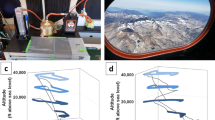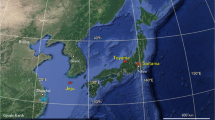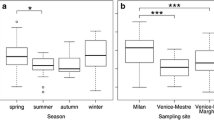Abstract
The study of airborne biological particles (‘bioaerosols’) has gained interest in recent years, due to an increasing amount of evidence suggesting that this fraction of airborne particulate matter may play a critical role in the negative effects of aerosols on biological systems. Pioneer investigations demonstrated that bacteria do exist in the atmosphere and can be metabolically active, although studies have not proved whether they actually form ecological communities or are merely assemblages of organisms passively transported from different sources. For a long time, cultivation-based methods have been the gold standard to describe and quantify airborne microorganisms. However, the use of culture-independent techniques and, more recently, of the next-generation sequencing-based methods, has improved the ability of the scientific community to investigate bioaerosols in detail and to address further research questions, such as the temporal and spatial variability of airborne bacterial assemblages, the environmental factors affecting this variability and the potential sources of atmospheric bacteria. This paper provides a systematic review of the state-of-the-art methodologies used in the study of airborne bacteria to achieve each of the aforementioned research objectives, as well as the main results obtained so far. Critical evaluations of the current state of the knowledge and suggestions for further researches are provided.
Similar content being viewed by others
References
Al-Bader D, Eliyas M, Rayan R, Radwan S (2012) Air-dust-borne associations of phototrophic and hydrocarbon-utilizing microorganisms: promising consortia in volatile hydrocarbon bioremediation. Environ Sci Pollut Res 19:3997–4005. doi:10.1007/s11356-012-0897-x
An HR, Mainelis G, White L (2006) Development and calibration of real-time PCR for quantification of airborne microorganisms in air samples. Atmos Environ 40:7924–7939. doi:10.1016/j.atmosenv.2006.07.020
Becker S, Dailey LA, Soukup JM, Grambow SC, Devlin RB, Huang YCT (2005) Seasonal variations in air pollution particle-induced inflammatory mediator release and oxidative stress. Environ Health Persp 113:1032–1038. doi:10.1289/ehp.7996
Bertolini V, Gandolfi I, Ambrosini R, Bestetti G, Innocente E, Rampazzo G, Franzetti A (2013) Temporal variability and effect of environmental variables on airborne bacterial communities in an urban area of Northern Italy. Appl Microbiol Biotechnol. doi:10.1007/s00253-012-4450-0, online first
Bowers RM, Lauber CL, Wiedinmyer C, Hamady M, Hallar AG, Fall R, Knight R, Fierer N (2009) Characterization of airborne microbial communities at a high-elevation site and their potential to act as atmospheric ice nuclei. Appl Environ Microbiol 75:5121–5130. doi:10.1128/AEM.00447-09
Bowers RM, McCubbin IB, Hallar AG, Fierer N (2012) Seasonal variability in airborne bacterial communities at a high-elevation site. Atmos Environ 50:41–49. doi:10.1016/j.atmosenv.2012.01.005
Bowers RM, McLetchie S, Knight R, Fierer N (2011a) Spatial variability in airborne bacterial communities across land-use types and their relationship to the bacterial communities of the potential source environments. ISME J 5:601–612. doi:10.1038/ismej.2010.167
Bowers RM, Sullivan AP, Costello EK, Collett JL Jr, Knight R, Fierer N (2011b) Sources of bacteria in outdoor air across cities in the Midwestern United States. Appl Environ Microbiol 77:6350–6356. doi:10.1128/AEM.05498-11
Brodie EL, De Santis TZ, Moberg Parker JP, Zubietta IX, Piceno YM, Andersen GL (2007) Urban aerosols harbor diverse and dynamic bacterial populations. Proc Natl Acad Sci U S A 104:299–304. doi:10.1073/pnas.0608255104
Buttner MP, Willeke K, Grinshpun SA (2002) Sampling and analysis or airborne microorganisms. In: Hurst CJ, Crawford RL, Knudsen G, McInerney M, Stetzenbach LD (eds) Manual of environmental microbiology, 2nd edn. ASM Press, Washington, DC, pp 814–826
Camatini M, Corvaja V, Pezzolato E, Mantecca P, Gualtieri M (2012) PM10-biogenic fraction drives the seasonal variation of proinflammatory response in A549 cells. Environ Toxicol 27:63–73. doi:10:1002/tox.20611
Caporaso JG, Lauber CL, Walters WA, Berg-Lyons D, Huntley J, Fierer N, Owens SM, Betley J, Fraser L, Bauer M, Gormley N, Gilbert JA, Smith G, Knight R (2012) Ultra-high-throughput microbial community analysis on the Illumina HiSeq and MiSeq platforms. ISME J 6:1621–1624. doi:10.1038/ismej.2012.8
Cho BC, Hwang CY (2011) Prokaryotic abundance and 16S rRNA gene sequences detected in marine aerosols on the East Sea (Korea). FEMS Microbiol Ecol 76:327–341. doi:10.1111/j.1574-6941.2011.01053.x
Clarke KR, Gorley RN (2006) PRIMER v6: user manual/tutorial. PRIMER-E, Plymouth
Cote V, Kos G, Mortazavi R, Ariya PA (2008) Microbial and de novo transformation of dicarboxylic acids by three airborne fungi. Sci Total Environ 390:530–537. doi:10.1016/j.scitotenv.2007.10.035
D’Amato G (2002) Environmental urban factors (air pollution and allergens) and the rising trends in allergic respiratory diseases. Allergy 57(Suppl 72):30–33. doi:10.1034/j.1398-9995.57.s72.5.x
D’Arcy N, Canales M, Spratt DA, Lai KM (2012) Healthy schools: standardisation of culturing methods for seeking airborne pathogens in bioaerosols emitted from human sources. Aerobiologia 28:413–422. doi:10.1007/s10453-012-9251-5
DeLeon-Rodriguez N, Lathem TL, Rodriguez-R LM, Barazesh JM, Anderson BE, Beyersdorf AJ, Ziemba LD, Bergin M, Nenes A, Konstantinidis T (2013) Microbiome of the upper troposphere: species composition and prevalence, effects of tropical storms, and atmospheric implications. P Natl Acad Sci USA. doi:10.1073/pnas.1212089110, online first
Després VR, Nowoisky JF, Klose M, Conrad R, Andreae MO, Pöschl U (2007) Characterization of primary biogenic aerosol particles in urban, rural, and high-alpine air by DNA sequence and restriction fragment analysis of ribosomal RNA genes. Biogeosciences 4:1127–1141. doi:10.5194/bg-4-1127-2007
Di Giorgio C, Krempff A, Guiraud H, Binder P, Tiret C, Dumenil G (1996) Atmospheric pollution by airborne microorganisms in the city of Marseilles. Atmos Environ 30:155–160. doi:10.1016/1352-2310(95)00143-M
Dungan RS (2010) Board-invited review: Fate and transport of bioaerosols associated with livestock operations and manures. J Anim Sci 88:3693–3706. doi:10.2527/jas.2010-3094
Dungan RS, Leytem AB (2009) Qualitative and quantitative methodologies for determination of airborne microorganisms at concentrated animal-feeding operations. World J Microb Biot 25:1505–1518. doi:10.1007/s11274-009-0043-1
Eames I, Tang JW, Li Y, Wilson P (2009) Airborne transmission of disease in hospitals. J R Soc Interface 6:S697–S702. doi:10.1098/rsif.2009.0407.focus
Eduard W, Heederik D, Duchaine C, Green BJ (2012) Bioaerosol exposure assessment in the workplace: the past, present and recent advances. J Environ Monitor 14:334–339. doi:10.1039/c2em10717a
Fahlgren C, Bratbak G, Sandaa RA, Thyrhaug R, Zweifel UL (2011) Diversity of airborne bacteria in samples collected using different devices for aerosol collection. Aerobiologia 27:107–120. doi:10.1007/s10453-010-9181-z
Fahlgren C, Hagström Å, Nilsson D, Zweifel UL (2010) Annual variations in the diversity, viability, and origin of airborne bacteria. Appl Environ Microbiol 76:3015–3025. doi:10.1128/AEM.02092-09
Fang Z, Ouyang Z, Zheng H, Wang X, Hu L (2007) Culturable airborne bacteria in outdoor environments in Beijing, China. Microb Ecol 54:487–496. doi:10.1007/s00248-007-9216-3
Fierer N, Liu Z, Rodríguez-Hernández M, Knight R, Henn M, Hernandez MT (2008) Short-term temporal variability in airborne bacterial and fungal populations. Appl Environ Microbiol 74:200–207. doi:10.1128/AEM.01467-07
Finnerty K, Choi JE, Lau A, Davis-Gorman G, Diven C, Seaver N, Linak WP, Witten M, McDonagh PF (2007) Instillation of coarse ash particulate matter and lipopolysaccharide produces a systemic inflammatory response in mice. J Toxicol Environ Health A 70:1957–1966. doi:10.1080/15287390701549229
Fong NJC, Burgess ML, Barrow KD, Glenn DR (2001) Carotenoid accumulation in the psychrotrophic bacterium Arthrobacter agilis in response to thermal and salt stress. Appl Microbiol Biotechnol 56:750–756. doi:10.1007/s002530100739
Franzetti A, Gandolfi I, Gaspari E, Ambrosini R, Bestetti G (2011) Seasonal variability of bacteria in fine and coarse urban air particulate matter. Appl Microbiol Biotechnol 90:745–753. doi:10.1007/s00253-010-3048-7
Fuzzi S, Mandrioli P, Perfetto A (1997) Fog droplets—an atmospheric source of secondary biological aerosol particles. Atmos Environ 31:287–290. doi:10.1016/1352-2310(96)00160-4
Gandolfi I, Franzetti A, Bertolini V, Gaspari E, Bestetti G (2011) Antibiotic resistance in bacteria associated with coarse atmospheric particulate matter in an urban area. J Appl Microbiol 110:1612–1620. doi:10.1111/j.1365-2672.2011.05018.x
Georgakopoulos DG, Després V, Fröhlich-Nowoisky J, Psenner R, Ariya PA, Pósfai M, Ahern HE, Moffett BF, Hill TCJ (2009) Microbiology and atmospheric processes: biological, physical and chemical characterization of aerosol particles. Biogeosciences 6:721–737. doi:10.5194/bg-6-721-2009
Griffin DW (2007) Atmospheric movement of microorganisms in clouds of desert dust and implications for human health. Clin Microbiol Rev 20:459–477. doi:10.1128/CMR.00039-06
Griffin DW, Gonzalez C, Teigell N, Petrosky T, Northup DE, Lyles M (2011) Observations on the use of membrane filtration and liquid impingement to collect airborne microorganisms in various atmospheric environments. Aerobiologia 27:25–35. doi:10.1007/s10453-010-9173-z
Haas D, Galler H, Luxner J, Zarfel G, Buzina W, Friedl H, Marth E, Habib J, Reinthaler FF (2013) The concentrations of culturable microorganisms in relation to particulate matter in urban air. Atmos Environ 65:215–222. doi:10.1016/j.atmosenv.2012.10.031ù
Harrison RM, Jones AM, Biggins PDE, Pomeroy N, Cox CS, Kidd SP, Hobman JL, Brown NL, Beswick A (2005) Climate factors influencing bacterial count in background air samples. Int J Biometeorol 49:167–178. doi:10.1007/s00484-004-0225-3
Hospodsky D, Yamamoto N, Peccia J (2010) Accuracy, precision and method detection limits of quantitative PCR for airborne bacteria and fungi. Appl Environ Microbiol 76:7004–7012. doi:10.1128/AEM.01240-10
Jeon EM, Kim HJ, Jung K, Kim JH, Kim MY, Kim YP, Ka JO (2011) Impact of Asian dust events on airborne bacterial community assessed my molecular analyses. Atmos Environ 45:4313–4321. doi:10.1016/j.atmosenv.2010.11.054
Korzeniewska E (2011) Emission of bacteria and fungi in the air from wastewater treatment plants—a review. Front Biosci 3:393–407. doi:10.2741/s159
Kuske CR (2006) Current and emerging technologies for the study of bacteria in the outdoor air. Curr Opin Biotechnol 17:291–296. doi:10.1016/j.copbio.2006.04.001
Lee SH, Lee HJ, Kim SJ, Lee HM, Kang H, Kim YP (2010) Identification of airborne bacterial and fungal community structures in an urban area by T-RFLP analysis and quantitative real-time PCR. Sci Total Environ 408:1349–1357. doi:10.1016/j.scitotenv.2009.10.061
Li K, Dong S, Wu Y, Yao M (2010) Comparison of the biological content of air samples collected at ground level and at higher elevation. Aerobiologia 26:233–244. doi:10.1007/s10453-010-9159-x
Lighthart B (1997) The ecology of bacteria in the alfresco atmosphere. FEMS Microbiol Ecol 23:263–274. doi:10.1111/j.1574-6941.1997.tb00408.x
Lighthart B, Shaffer BT (1995a) Viable bacterial aerosol particle size distributions in the midsummer atmosphere at an isolated location in the high desert chaparral. Aerobiologia 11:19–25. doi:10.1007/BF02136140
Lighthart B, Shaffer BT (1995b) Airborne bacteria in the atmosphere surface layer: temporal distribution above a grass seed field. Appl Environ Microbiol 61:1492–1496
Longhin E, Pezzolato E, Mantecca P, Holme JA, Franzetti A, Camatini M, Gualtieri M (2013) Season linked responses to fine and quasi-ultrafine Milan PM in cultured cells. Toxicol in Vitro 27:551–559. doi:10.1016/j.tiv.2012.10.018
Mahdy HM, El-Sehrawi MH (1997) Airborne bacteria in the atmosphere of El-Taif region, Saudi Arabia. Water Air Soil Poll 98:317–324. doi:10.1007/BF02047041
Mancinelli RL, Schulls WA (1978) Airborne bacteria in an urban environment. Appl Environ Microbiol 35:1095–1101
Marchant R, Franzetti A, Pavlostathis SG, Tas DO, Erdbrugger I, Unyayar A, Mazmanci MA, Banat IM (2008) Thermophilic bacteria in cool temperate soils: are they metabolically active or continually added by global atmospheric transport? Appl Microbiol Biotechnol 78:841–852. doi:10.1007/s00253-008-1372-y
Maron PA, Lejon DPH, Carvalho E, Bizet K, Lemanceau P, Ranjard L, Mougel C (2005) Assessing genetic structure and diversity of airborne bacterial communities by DNA fingerprinting and 16S rDNA clone library. Atmos Environ 39:3687–3695. doi:10.1016/j.atmosenv.2005.03.002
Maron PA, Mougel C, Lejon DPH, Carvalho E, Bizet K, Marck G, Cubito N, Lemanceau P, Ranjard L (2006) Temporal variability of airborne bacterial community structure in an urban area. Atmos Environ 40:8074–8080. doi:10.1016/j.atmosenv.2006.08.047
Millner PD (2009) Bioaerosols associated with animal production operations. Bioresource Technol 100:5379–5385. doi:10.1016/j.biortech.2009.03.026
Moorman JE, Zahran H, Truman BI, Molla MT (2011) Current asthma prevalence—United States, 2006–2008. MMWR Surveill Summ 60(Suppl):84–86
Morris CE, Sands DC, Bardin M, Jaenicke R, Vogel B, Leyronas C, Ariya PA, Psenner R (2011) Microbiology and atmospheric processes: research challenges concerning the impact of airborne micro-organisms on the atmosphere and climate. Biogeosciences 8:17–25. doi:10.5194/bg-8-17-2011
O'Hara RE, Rubin R (2005) Reducing bioaerosol dispersion from wastewater treatment and its land application: a review and analysis. J Environ Health 68:24–29
Peccia J, Hernandez M (2006) Incorporating polymerase chain reaction-based identification, population characterization, and quantification of microorganisms into aerosol science: a review. Atmos Environ 40:3941–3961. doi:10.1016/j.atmosenv.2006.02.029
Polymenakou PN (2012) Atmosphere: a source of pathogenic or beneficial microbes? Atmosphere 3:87–102. doi:10.3390/atmos3010087
Polymenakou PN, Mandalakis M, Stephanou EG, Tselepides A (2008) Particle size distribution of airborne microorganisms and pathogens during an intense African dust event in the Eastern Mediterranean. Environ Health Persp 116:292–296. doi:10.1289/ehp.10684
Ravva SV, Hernlem BJ, Sarreal CZ, Mandrell RE (2012) Bacterial communities in urban aerosols collected with wetted-wall cyclonic samplers and seasonal fluctuations of live and culturable airborne bacteria. J Environ Monit 14:473–481. doi:10.1039/clem10753d
Rinsoz T, Duquenne P, Greff-Mirguet G, Oppliger A (2008) Application of real-time PCR for total airborne bacterial assessment: comparison with epifluorescence microscopy and culture dependent methods. Atmos Environ 42:6767–6774. doi:10.1016/j.atmosenv.2008.05.018
Sattler B, Puxbaum H, Psenner R (2001) Bacterial growth in supercooled cloud droplets. Geophys Res Lett 28:239–242. doi:10.1029/2000GL011684
Shaffer BT, Lighthart B (1997) Survey of culturable airborne bacteria at four diverse locations in Oregon: urban, rural, forest, and coastal. Microb Ecol 34:167–177. doi:10.1007/s002489900046
Smith DJ, Jaffe DA, Birmele MN, Griffin DW, Schuerger AC, Hee J, Roberts MS (2012) Free tropospheric transport of microorganisms from Asia to North America. Microb Ecol 64:973–985. doi:10.1007/s00248-012-0088-9
Stetzenbach LD, Buttner MP, Cruz P (2004) Detection and enumeration of airborne biocontaminants. Curr Opin Microbiol 15:170–174. doi:10.1016/j.copbio.2004.04.009
Tang JW (2009) The effect of environmental parameters on the survival of airborne infectious agents. J R Soc Interface 6:S737–S746. doi:10.1098/rsif.2009.0227.focus
Temkiv TS, Finster K, Hansen BM, Nielsen NW, Karlson UG (2012) The microbial diversity of a storm cloud as assessed by hailstones. FEMS Microbiol Ecol 81:684–695. doi:10.1111/j.1574-6941.2012.01402.x
Tong YY, Lighthart B (1997) Solar radiation is shown to select for pigmented bacteria in the ambient outdoor atmosphere. Photochem Photobiol 65:103–106. doi:10.1111/j.1751-1097.1997.tb01884.x
Tringe SG, Zhang T, Liu X, Yu Y, Lee WH, Yap J, Yao F, Suan ST, Ing SK, Haynes M, Rohwer F, Wei CL, Tan P, Bristow J, Rubin EM, Ruan Y (2008) The airborne metagenome in an indoor urban environment. PLoS ONE 3:10. doi:10.1371/journal.pone.0001862
Urbano R, Palenik B, Gaston CJ, Prahter KA (2011) Detection and phylogenetic analysis of coastal bioaerosols using culture dependent and independent techniques. Biogeosciences 8:301–309. doi:10.5194/bg-8-301-2011
Vaïtilingom M, Attard E, Gaiani N, Sancelme M, Deguillaume L, Flossmann AI, Amato P, Delort AM (2012) Long-term features of cloud microbiology at the puy de Dôme (France). Atmos Environ 56:88–100. doi:10.1016/j.atmosenv.2012.03.072
Womack AM, Bohannan BJM, Green JL (2010) Biodiversity and biogeography of the atmosphere. Philos Trans R Soc B Biol Sci 365:3645–3653. doi:10.1098/rstb.2010.0283
Xu Z, Wu Y, Shen F, Chen Q, Tan M, Yao M (2011) Bioaerosol science, technology, and engineering: past, present, and future. Aerosol Sci Tech 45:1337–1349. doi:10.1080/02786826.2011.593591
Zweifel UL, Hagström Å, Holmfeldt K, Thyrhaug R, Geels C, Frohn LM, Skjøth CA, Karlson UG (2012) High bacterial 16SrRNA gene diversity above the atmospheric boundary layer. Aerobiologia 28:481–498. doi:10.1007/s10453-012-9250-6
Acknowledgments
Our research on airborne bacteria was partially funded by Cariplo Foundation in the frame of the Project TOSCA (Toxicity of PM and molecular markers of risk), and by the Italian Ministry of Research—MIUR (Grant: PRIN 2010–2011-2010WLNFY2_005).
Author information
Authors and Affiliations
Corresponding author
Rights and permissions
About this article
Cite this article
Gandolfi, I., Bertolini, V., Ambrosini, R. et al. Unravelling the bacterial diversity in the atmosphere. Appl Microbiol Biotechnol 97, 4727–4736 (2013). https://doi.org/10.1007/s00253-013-4901-2
Received:
Revised:
Accepted:
Published:
Issue Date:
DOI: https://doi.org/10.1007/s00253-013-4901-2




